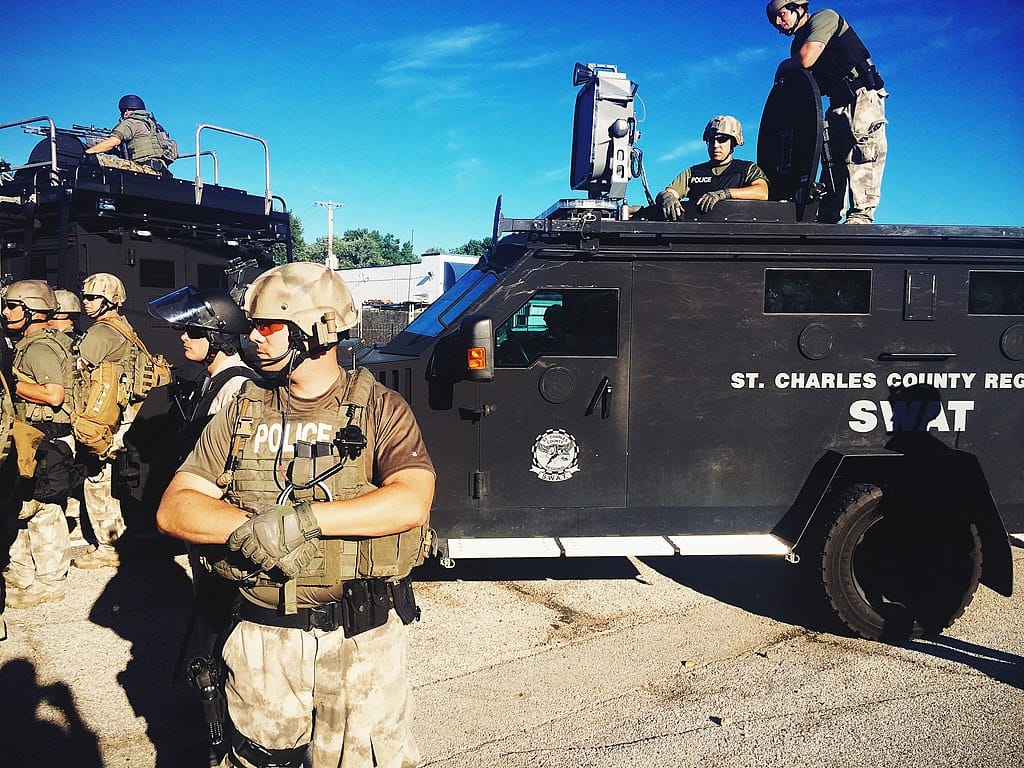SWAT / swatting

SWAT is a US police acronym of the phrase Special Weapons and Tactics. A SWAT team is a paramilitary police unit trained and equipped to engage in situations where violence was expected, such as hostage situations and drug raids.
According to Mitchel P. Roth’s Historical Dictionary of Law Enforcement, the first SWAT teams were formed in Philadelphia in 1964 in response to a series of bank robberies. And from there, the concept expanded to other cities, notably Los Angeles. But I have been unable find any primary source documentation for this claim. Perhaps the Philadelphia police had the concept but not the name. (Despite being labeled a Historical Dictionary, Roth's book contains no usage citations.)
The earliest use of SWAT or Special Weapons and Tactics that I have found is in a plan to combat riots formulated by Daryl F. Gates, who would later become chief of the Los Angeles Police Department, that was submitted to the National Advisory Commission on Civil Disorders in October 1967:
SPECIAL WEAPONS AND TACTICS TEAM (SWAT – TEAMS)
[…]
Composed of four permanent team members (including one Special Weapons Marksman, one observer and two shotgun men). SWAT Teams operate as team (or combined with other SWAT Teams as squads or platoons) to form special tactical missions upon request of the Field Commander.
The report was not initially made available to the public, and the first public reference to SWAT teams that I’m aware of is on 15 February 1968 when the Associated Press reported on the Los Angeles Police Departments plan to create such teams:
A new concept called SWAT is included in a comprehensive antiriot plan developed by the Los Angeles Police Department, which had to cope with the disastrous 1965 Watts riots.
The plan is in a 150-page outline disclosed today but prepared and published last month at the request of the President’s Commission on Civil Disorders.
“We have a SWAT team,” said police inspector Merton W. Howe, commander of tactical operations planning for the department. “That’s our Special Weapons and Tactics team which breaks into four-man groups—a rifleman whose weapon has telescopic sights, a spotter and two officers with shotguns and hand guns to provide cover fire.”
Initially designed as a response to public unrest in the late 1960s, the concept gained traction and rapidly expanded to police departments across the United States as part of the “War on Drugs” and the growing militarization of American police forces.
More recently, swat has become a slang term for harassing someone by making a false report of a violent situation with the intent of having victim arrested or even killed by a police SWAT team. The slang term dates to at least October 2006 when the Journal News of White Plains, New York reported on the practice:
A telephone call had come into the Yonkers police dispatcher moments before that traced back to Fata’s apartment. The caller had told the dispatcher that he had cut his girlfriend’s throat, was armed with an assault rifle and would shoot any police officer who came near him.
[…]
At police headquarters, detectives questioned him for several hours and replayed the 911 call. Although Caller ID said the call came from Fata’s apartment, detectives eventually realized it was his voice on the tape.
And while Yonkers police are now declining to comment on the case, other than to say it was closed, by all appearances Fata was the likely victim of a legal phenomenon known as “spoofing,” coupled with an illegal phenomenon known as “swatting.”
Spoof cards and Web sites have been around for several years. They allow anyone to pay a fee to change the number that appears on the Caller ID service of the person they are calling. But in recent years, there has been a rise in the illegal use of the cards to make false reports to police.
Sources:
Associated Press. “L.A. Riot Control Plan Is New Concept.” Jackson Sun (Tennessee), 15 February 1968, 9-A/5–6. ProQuest Historical Newspapers.
Gates, Daryl F. “Model Civil Disturbance Control Plan.” National Advisory Commission on Civil Disorders, 30 October 1967, 110. In Civil Rights During the Johnson Administration, Part 5: Record of the National Advisory Committee on Civil Disorders (Kerner Commision), Subject Files of the Associate Director for Public Safety (Series 21), Police Mobilization During Riots, October 27, 1967–October 30, 1967. ProQuest.
Hughes, Bill. “Caller ID Pranks Causing Trouble.” Journal News (White Plains, New York), 30 October 2006, 1B/6–2B/1. ProQuest Historical Newspapers.
Oxford English Dictionary, second edition, 1989, s.v. SWAT, n.
Roth, Mitchel P. Historical Dictionary of Law Enforcement. Westport, Connecticut: Greenwood Press, 2001, s.v. Special Weapons and Tactics (SWAT), 333–334. Pro-Quest Ebook Central.
Urbandictionary.com, 18 December 2007, s.v. swatting.
Photo credit: Jamelle Bouie, 13 August 2014. Wikipedia. Use under a Creative Commons Attribution 2.0 Generic license.